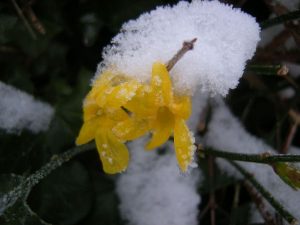A year of snowfall; snow fell of a quality not seen in Edinburgh for several years. On the 9th February; we even resorted to attaching the snow plough to the front of the tractor. It was six years previously when we last used the snowplough in the garden.
Following the melt we were rewarded with the best flowering season for Rhododendron, Magnolia and Bluebells for many years. Apart from a couple of mornings early in the season when blossom was damaged by early morning sun on frosted plants there were no other spoilt blooms.
The season continued with herbaceous flowering of an equally high standard. All in all the best flowering season that I can remember – ever.
May was cold and dry; the soil took a long time to warm up but the weed seeds germinated just to prove there is life in the soil. Then the 29th dawned, the sun rose at 4.30 am and burnt a continuous groove in the sunshine recording card until a cloud passed at 6.50pm and then shone briefly again for a further 15 minutes.
The following day this was beaten; continuous sunshine from 4.30am until 7.20pm with a maximum temperature of 24.9oc. Was it this combination of weather that allowed the production of much cuckoo spit; evident from late May through June?
Following the max. temp of the year on 2 July of 29.9oc, (only beaten by the 5th August 1975 at 30oc), the summer became warm and humid with the usual torrential rainfall we now expect. Following 36 hours of continuous rain during August a Betula utilis collapsed with a rotted root plate. A changing climate? This is the fourth year now where the European monsoon drenches us through August with torrential rain brought in by westerly winds from the Atlantic. Thereafter we then experience long dry Indian summers. This year lasting well into late October.
The weather pattern stabilised in September. Autumn colour started very early with good leaf tints from mid September; Betula, Sorbus and Euonymus leading the way.
The first V formation of Geese passed overhead, flying south, on the last day of September. The first white ground frost in the morning of Saturday 17th October added ambiance to the exceptional autumn colour.
November was wet. The highest November rainfall for two decades. In total 125.6mm of rain fell throughout the month. Since 1990 only November 2000 produced more than 100mm of rain (103.3mm). The ground was sodden and still is. It makes horticulture difficult to practice when soil becomes unworkable with this level of rainfall and unpleasant to work outdoors.
The Garden experienced the first snow of the winter on 17th December and then it just kept snowing. It is unusual to have such a prolonged snowfall at the end of the year and makes for a long winter. Deep cold will sort the wheat from the chaff with regard to survival of dubiously hardy plants. The reliable Winter Jasmine,
is a winner no matter what the climate throws at it. This is the one to draw the wallet from the pocket when contemplating a purchase. Other members of the genus may exude a delightful perfumed scent but will not flower with such reliability.
With the soil sodden and largely unworkable; what to do? Concentrate your mind on herbs. How many times do we realise at the last minute that a selection of herbs is essential to add flavour to the Christmas dinner? How many times do we reach for the dried shop bought version? Pulling long forgotten bottles from the back of the cupboard. Now is the time to draw up the selection of herbs to be planted in 2010 within easy reach of the kitchen door or in the window box on the kitchen window ledge. To the staples; Rosemary, Bay, Thyme and Mint can be added the more tender and annual members of the group; Sage, Parsley, Dill, Coriander. Read and research in the warmth of your home and be ready to sow and plant with lengthening days.
Best wishes for the New Year and successful cultivation through 2010.


